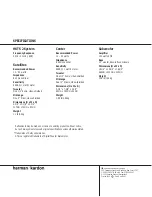
11
If there is no sound from any of the
speakers:
• Check that receiver/amplifier is on and a
source is playing.
• Check that the powered subwoofer is
plugged in and its Power switch
¡
is
switched on to the “
•
” position.
• Check all wires and connections between
receiver/amplifier and speakers. Make sure
all wires are connected. Make sure none
of the speaker wires are frayed, cut or
punctured.
• Review proper operation of your
receiver/amplifier.
If there is no sound coming from one
speaker:
• Check the “Balance” control on your
receiver/amplifier.
• Check all wires and connections between
receiver/amplifier and speakers. Make sure
all wires are connected. Make sure none
of the speaker wires are frayed, cut or
punctured.
• In Dolby Digital or DTS modes, make sure
that the receiver/processor is configured so
that the speaker in question is enabled.
If there is no sound from the center
speaker:
• Check all wires and connections between
receiver/amplifier and speaker. Make sure
all wires are connected. Make sure none
of the speaker wires are frayed, cut or
punctured.
• If your receiver/processor is set in Dolby
Pro Logic mode, make sure the center
speaker is not in phantom mode.
• If your receiver/processor is set in Dolby
Digital or DTS mode, make sure the
receiver/processor is configured so
that the center speaker is enabled.
If the system plays at low volumes
but shuts off as volume is increased:
• Check all wires and connections between
receiver/amplifier and speakers. Make sure
all wires are connected. Make sure none
of the speaker wires are frayed, cut or
punctured.
• If more than one pair of main speakers is
being used, check the minimum impedance
requirements of your receiver/amplifier.
If there is low (or no) bass output:
• Make sure the connections to the left and
right “Speaker Inputs” have the correct
polarity (+ and –).
• Make sure the subwoofer is plugged into
an active electrical outlet.
• Make sure the powered subwoofer is
plugged in and its power switch
¡
is
switched on to the “•” position.
• In Dolby Digital or DTS modes, make
sure your receiver/processor is configured
so that the subwoofer and LFE output are
enabled.
If there is no sound from the sur-
round speakers:
• Check all wires and connections between
receiver/amplifier and speakers. Make sure
all wires are connected. Make sure none
of the speaker wires are frayed, cut or
punctured.
• Review proper operation of your
receiver/processor and its surround-sound
features.
• Make sure the movie or TV show you are
watching is recorded in a surround-sound
mode. If it is not, check to see if your
receiver/processor has other surround
modes you may use.
• In Dolby Digital or DTS modes, make sure
your receiver/processor is configured so that
the surround speakers are enabled.
• Review the operation of your DVD player
and the jacket of your DVD to make sure
that the DVD features the desired Dolby
Digital or DTS mode, and that you have
properly selected that mode using both the
DVD player’s menu and the DVD disc’s
menu.
TROUBLESHOOTING






























